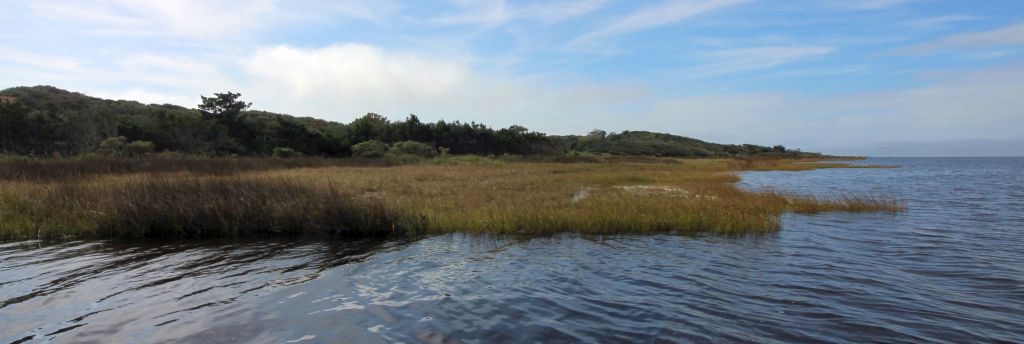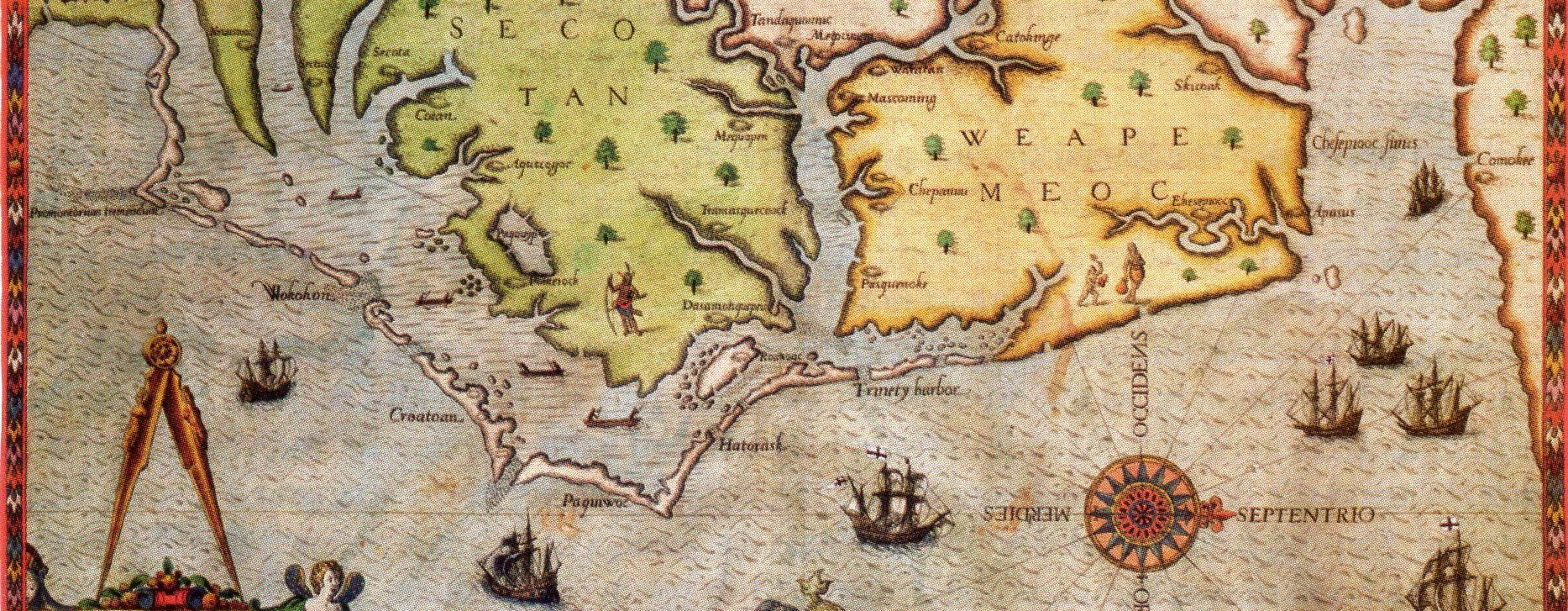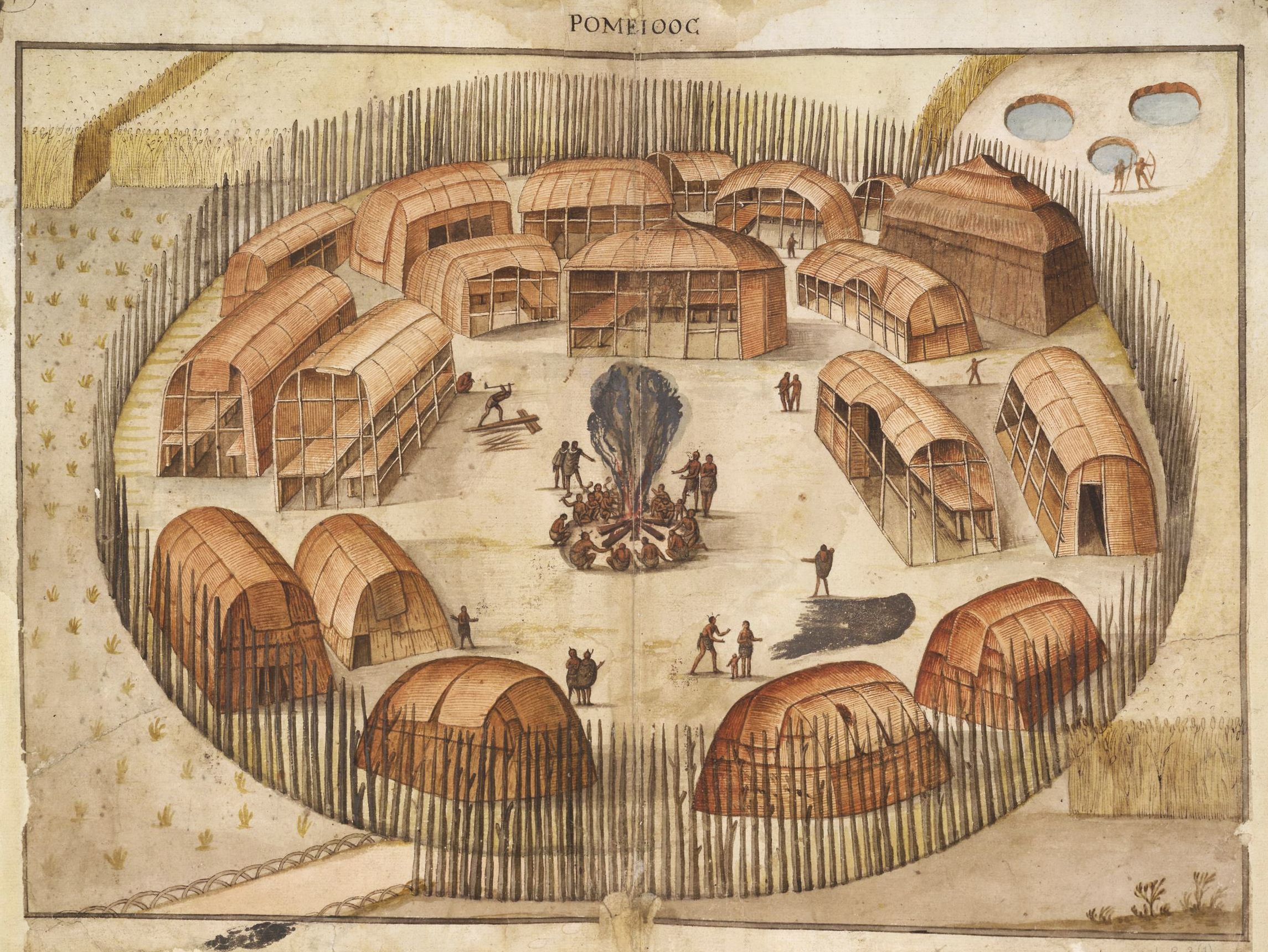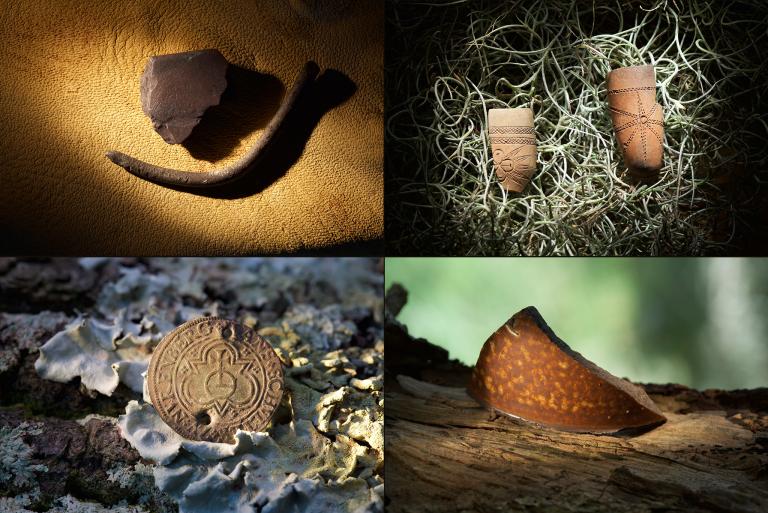What happened to the first English colonists in North America, who supposedly disappeared without a trace? Our recent archaeological discoveries may have solved the riddle.
-
November 2020
Volume65Issue7
Editor’s Note: Scott Dawson, founder of the Croatoan Archaeological Society, has been the driving force behind ten years of archaeological excavations on Hatteras Island that have led to a new understanding of what may have happened to the abandoned settlers. His recent book, The Lost Colony and Hatteras Island, contains more information about his team’s important discoveries.

The story of the “Lost Colony” – the disappearance of the first English settlers in America – is one of the most famous legends in history.
It goes like something this: in 1587, thirty-three years before the Mayflower and twenty years before Jamestown, more than one hundred men, women, and children established a settlement on Roanoke Island in what is now the Outer Banks of North Carolina. After a palisade and some rudimentary dwellings were built, the governor of the colony, John White, returned to England for supplies. But he couldn’t get back for three years because of war with Spain.
When White finally returned to Roanoke, there was no trace of the colony, which had included his daughter and granddaughter. Even the houses were gone. All that was left was a mysterious message carved on a tree that said “CROATOAN.” No one had a clue what it meant. Thus, the “lost” colony.

That legend, passed down through generations and augmented by popular media and many textbooks, is largely false. My twenty years of research in primary sources about the first English settlements in North America and ten years of archaeological digs on Hatteras have led to a new understanding of what actually happened to the colony. The truth is far more interesting than the legend.
In fact, the colony was never lost but rather abandoned at Croatoan — modern-day Hatteras Island. Authorities in England in the 1600s and 1700s were aware of gray-eyed Indians wearing English-style clothing. John Lawson, an explorer hired by the Crown in 1701 to survey Native tribes in the Carolinas, wrote of the Croatoans that, “These tell us, that several of their Ancestors were white People, and could talk in a Book, as we do.” He expressed his horror that in order to survive the colonists had “degenerated” and assimilated with the Natives, who were often called “savages” by English at the time.

In 1710 an English missionary in North Carolina, Rev. John Irmstone, wrote that people from Hatteras had come to him to be baptized and that “these people are half Indian and half English.” Irmstone felt these people were “an offense to my own” for living with the Croatoans and writes he “gravely doubts the Kingdom of Heaven was designed to accommodate such people.”
The fact is, for four centuries until our own time, racism has played an ugly part in hiding the truth about the “Lost Colony,” whose survivors lived and eventually intermarried with the friendly Croatoan Indians. Records shows that of the 115 original colonists, 86 were single men and only eight were single women. It is not surprising what eventually happened: men, women and children from two different worlds and cultures became one family.

My family has lived on Hatteras for generations, and family lore says that we ourselves are partly descended from members of the Croatoan tribe from the 1700s. Native American pottery frequently turns up on Hatteras Island, but in recent years people have been building houses on top of Indian villages left and right.
I started out with a limited goal: to find enough Indian pottery to put together a bowl and give it to the high school so our students would know there were Croatoan Indians who lived on the island. When I was poking around, I found a piece of a European olive jar from the 16th century.
As I found additional materials, more people became interested. For the last ten years, full-scale archaeological excavations on Hatteras Island have yielded a wealth of artifacts and knowledge. Archaeologist Mark Horton from the University of Bristol, England, his team, and our Croatoan Archaeological Society (CAS) volunteers have unearthed history-changing material.
European politics affected the colony
The circumstances of the colony were part of the larger story of the Anglo-Spanish War. Although the fighting from 1585 to 1604 was chiefly between England and Spain, it also involved the Netherlands, Ireland and Portugal and even spilled into the Caribbean and what is now Florida and North Carolina.
The war was the number-one driving force behind English attempts at settlement in the New World and influenced when and where they settled: the Outer Banks were the perfect location for a base from which to attack ships returning to Spain laden with silver and gold.
Another story within the larger context of the Anglo-Spanish War was the very personal conflict between Queen Elizabeth of England and King Philip II of Spain. He had been the husband of Queen Elizabeth’s older half sister, Mary Tudor, who was known as “Bloody Mary” for the hundreds of English Protestants she had burned at the stake during her five-year reign as Queen of England. The Archbishop of Canterbury was forced to watch as several of his bishops were executed. Then he, too, was burned at the stake.

After Queen Mary’s death in 1558, Elizabeth became queen and reestablished the Church of England. But the country remained bitterly divided along religious lines, and Elizabeth constantly had to deal with internal dissension as well as foreign enemies, with Philip of Spain launching the Spanish Armada against England in 1588.
Also occurring simultaneously was the often-neglected local conflict between the Croatoan Indians of Hatteras and the Secotan tribe that lived in the mainland tidewater area and surrounding the English settlement on Roanoke island. The newcomers would get drawn into that conflict between rival Algonquian tribes with fatal consequences.
All these conflicts affected the destiny of the Lost Colony and the many moving parts that make up the true history of what happened.
English expeditions of the 1580s
The “Lost Colony” established in 1587 on Roanoke was actually the fourth expedition sent to North Carolina by the English. In 1584, Sir Walter Raleigh, under a patent from Queen Elizabeth, had launched the first voyage to what is now the United States. This reconnaissance mission sought a naval base in the New World for privateers to launch raids against the Spanish. The queen would get 10% of the value of the prizes, and only the Spanish were to be attacked.
The southern half of the Outer Banks was just what the English wanted for a place from which to loot Spanish merchant ships laden with treasure, which sailed north on the Gulf Stream to return to Spain. At no point is land closer to the massive ocean current than at Hatteras and Ocracoke islands, which would be used by pirates and privateers for 150 more years for exactly the same reason.

On July 4, 1584 a ship sent by Raleigh crossed the Outer Banks, sailed into Pamlico Sound, and anchored off an island said to be 20 miles long. “We walked away from the shore toward the nearby hilltops,” wrote Capt. Arthur Barlowe. “From this spot we could view the sea on both sides, to the north and to the south, as far as the eye could see.” The description most likely fits Hatteras island, although it might possibly have been Ocracoke.
The first ever meeting between the English and Native Americans occurred when three curious Native men took canoes to a point of land opposite where Barlow’s ship had anchored. One of them paddled out and exchanged goods and food. Later the English traded with both the Croatoan and Secotan tribes, who especially desired iron tools, glass beads, and copper. After the explorers had remained six weeks on the islands, they sailed back to England taking one young man from each tribe, Manteo and Wanchese, to learn English and be presented to the Court.

In the following April 1585, Sir Richard Grenville set off with a fleet of ships for the New World with both Manteo and Wanchese aboard. The first ship to reach the Outer Banks dropped 32 men off at Croatoan and then continued on its way north. A couple of weeks later, Grenville arrived and, with the help of Manteo, negotiated for land for a settlement on Roanoke Island.
Unfortunately, the honeymoon didn’t last. Over the next months as the English visited various Native villages, many Indians came to believe that the newcomers slowly drained the life out of their people because so many became weak and died from mysterious diseases.
When the colony’s governor Ralph Lane discovered that a silver cup had been stolen by the Secotan, he ordered the village of Aquascogoc and its crops burned to avoid an appearance of weakness. Although the Croatoan Indians remained friendly, this was the beginning of a downward spiral for relations between the English and the Secotan, who planned to kill or starve the English on Roanoke. They were only saved when an English contingent on Croatoan island spotted Sir Francis Drake’s ship, which took most of the men back to England, leaving fifteen to maintain the settlement.

The “Lost Colony” of 1587
While the previous three voyages were primarily military operations and trading ventures, the fourth expedition to the Outer Banks in 1587 was the only settlement meant to last – the first English voyage to bring women and children. The new governor John White arrived with 115 colonists including his pregnant daughter Eleanor and her husband and moved into the buildings begun at Roanoke. The original plan was to eventually move north to a place with a deeper harbor near the Indian village of Chesepioc (at the base of the Chesapeake Bay.)
White was shocked to find the fifteen men left behind by Lane the previous year had disappeared. Then one of the new colonists, George Howe, was killed by Indians from the adjacent mainland. After this murder happened, the colony sent twenty-five colonists to Croatoan with Manteo to get help. The Croatoans hosted the English to a feast and told them it was the Secotan tribe who had killed the fifteen men, to no one’s surprise.

The Croatoan agreed to talk with the Secotan to try to negotiate peace for the English. Instead, however, they sacked another Secotan village on the mainland and gave the corn and pumpkins left behind to the English. All of this happened before Governor White left for English to get resupplies. So he was well aware of the dangerous environment the colony was in.
As White left, he told the colonists that if they left Roanoke Island they should carve out the name of where they were relocating to on a tree and notch a cross under the name if they left in distress. He also left them with small boats called “pinnaces” as well as canoes. So if they needed to move the fifty miles south to Hatteras, they could have knocked out the wooden pins from the posts and beams, and moved the houses to be reconstructed in a safer environment.
When Governor White returned in 1590 with supplies, three years after he left the colonists on Roanoke, he saw the message of “Croatoan” and knew exactly what it meant and where they had gone. He and the crew agreed to go to Croatoan and resupply the colony. Unfortunately, a storm, coupled with near mutiny among the crew, prevented him from reconnecting. White later wrote that he was greatly joyful to find a certain “token” (message on the tree) of the colony being at Croatoan, the place where Manteo was born and where the people were friends of the English. There was no cross underneath, so presumably they were safe.

The Native population of Hatteras and the other Outer Banks islands probably numbered well over a thousand in the 1500s, and they could easily have sustained an additional hundred or so English refugees from Roanoke. But what evidence is there that this happened?
Since written records about the Native people are largely limited to the period after contact with Europeans began, we must rely on archaeology to tell us about life in the New World before and after European contact. Archaeology gives us a look at the actual tools, weapons, diet, homes and goods people had and used at a particular time in history. By studying the artifacts found in successive layers, it can also demonstrate the rate of assimilation between the two cultures.
For as long as anyone can remember, the local people of Hatteras Island have been unearthing artifacts while building homes or playing in the woods. In the 1920s, my great-grandfather Eustes White found an intact Spanish olive jar that stands a foot tall in one of my family member’s homes today. It was examined by Professor Horton who said it appears to be a Spanish olive jar from the sixteenth century – probably the oldest intact European ceramic ever found in North Carolina.
We know that Sir Francis Drake stole several olive jars of this type in 1585 from Spanish colonies in Florida, and that olive oil was used in England to process the number-one export: wool. After Drake took the jars from Florida, he made his way to Croatoan, where he lost a ship from his fleet called the Francis to bad weather. Was this olive jar once on the Francis? Or was it from the wreck of the 1560s Spanish ship that the Croatoan told the English about? It’s impossible to say because the jar was not found in context.

The first preliminary archaeological work on Hatteras Island was done in the 1930s and 1940s. These were mostly surveys limited in scope, but convincing enough to have certain sites designated as areas of interest. A local resident gave one of the archaeologists a Nuremburg token believed to be from 1500s. This casting counter looks like a coin and would have been used to count inventory on a ship. Although not found in context, it was similar to a token found in Jamestown.
In 1993, Hurricane Emily hit Hatteras hard and after the storm local residents discovered a mass of Native artifacts on the Pamlico Sound side in Buxton. “Enough to fill the back of a pickup truck,” said one of them, Fred Willard. And when a massive oak tree blew over near Buxton a local resident found a Cumberland type of spearhead when the roots were dug out. Experts say it dates back thirteen thousand years – more than twice the age of the pyramids of Giza in Egypt!

In November 2009, Professor Mark Horton of the University of Bristol and PhD candidate Louisa Pittman came to Hatteras Island and conducted eight test pits in varying areas on the island, including Buxton and Frisco. One site at Frisco was a purely Native site that turned out to be Mid-Woodland, but in Buxton a pit revealed mostly Croatoan with some European context mixed in – right on the money for the contact period based on the pottery. A perfect sequence of colonial artifacts from 1750 down to 1650 was found mixed with Native material, meaning the sixteenth century could be just below these finds waiting to be dug up. These items included an unfired musket ball, some earthenware, and a pipe.
The following year Prof. Horton excavated a homestead that turned up coins, glass bottles, English ceramics and a piece of eight minted in Mexico. These were easy to date as being in the 1730s or 1740s. As we dug around and below this homestead, we began to find Croatoan material and English artifacts that appeared to be from the 1600s including delft pottery, tobacco pipes, a horse bridle, and a shoe buckle with part of the word “Chatham” etched on it, together with a lot of shellfish, turtle, deer, and coyote bones. Also, we also found bow-drill stones, which would have been used to start fires.
So here were English items found in what was clearly a Native village. Given the number of European shipwrecks on Hatteras at least as early as the 1560s, these could have been left by castaways, pirates, or runaway indentured servants living on Hatteras with the Indians. How it got there would not be answered until later.

By the end of our two-week dig in 2012, we had reasons to believe we might find a slightly older layer just a few meters away. Immediately, we started to find Croatoan pipes and pottery alongside tiny lead shot balls, English gunflints and a few random iron objects. As we dug a little deeper, we found glass trade beads and decorative pipe bowls made by American manufacturer Emmanuel Drew between 1650 and 1669.
We also found the postholes of the longhouses and possibly a smokehouse. There were a few very odd things found, like a Dutch coin weight from 1648 and a Scottish gold penny from 1644. Other rare finds were a copper key to a pocket watch, a gun barrel and some very old glass that, as we discovered later, predated 1600.

Near the glass was some stoneware that was made in both the sixteenth and seventeenth centuries. It appeared we had finally reached the sixteenth century. Croatoan pottery and pipes were mixed in the same layer as the stoneware and lead light glass. The story of the missing century (1600s) appears to be that the Croatoan were thriving and very well fed based on the middens. They were using iron tools and English guns, wearing pocket watches and drinking brandy. In other words, we had evidence of assimilation going on at least as early as 1650 and possibly earlier.
While that pit was being excavated, we dug a larger trench thirty feet away where auger holes had shown evidence of another midden. Attention turned to this trench when postholes of a possible smokehouse were discovered. A smokehouse was a holy place for the Croatoan. The entrance of a smokehouse always faced east toward the rising sun, where life begins. The building itself was like a small wooden igloo with a fire pit in the center that one had to crawl into to enter.

Artifacts provide clues
The next year we finally hit the sixteenth century, exceeding the hopes of even the most optimistic among us. Some large square nails turned up, and other iron objects we couldn’t identify due to the balls of rust around them. Dr. Horton held up one that looked like a door hinge, but after three days of cleaning with electrolysis proved to be the hilt of an Elizabethan-era rapier. This was significant because early the leaders of the colony wrote that the Natives would have traded anything for a guns or swords, but that the English would not part with any. Since the sword was found in the context of a layer dating from the 1500s, it could well have been owned by an English settler on Croatoan.
Just as we were finding the sword hilt, Dr. Horton unearthed two pieces of a writing slate with a pencil a few inches away. This was not the sort of thing that would be traded to the Croatoan because they didn’t have writing. A later analysis by NASA found a faint drawing of a man shooting a gun.
We also found the ultimate repurposed tool: an arrowhead fashioned out of glass by some Native craftsman. The Croatoan had no glass, so the glass probably came from the English. Finding English goods in the Croatoan villages makes sense and is more evidence that the colony may have assimilated there.
What would life have been like?
If the abandoned colonists did relocate to Croatoan, what would their new life have been like? The Croatoan and many Native Americans are unfairly stereotyped as eking out a living from the land and living a barbaric, primitive life. In reality, the Croatoan had agriculture; lived in houses and towns; had organized government and religion; traded extensively with other tribes; and lived long, healthy lives. They knew the Earth was round and that it went around the sun long before Europeans did. Thomas Harriot, the English scientist and mathematician who lived with the Natives for a year in 1585, even suggested that the Native diet be copied by the English because they were so “long lived.”
Hunting and fishing were a huge part of the diet and everyday life of the Native Croatoan. The main animal hunted was deer. Not only could the animal provide a lot of meat but also clothing. The same was true for black bear, which were (and still are) numerous on the North Carolina mainland. The hamstrings of the deer were used for the strings of bows, and the antlers were used for a variety of tools and even as pipe bowls. Bows and arrows were the main weapons used to hunt deer, although spears were also used.

The Natives did not practice farming on a large scale, but did live in permanent towns with sizable gardens. We know the people on Hatteras lived there year-round because of the types of shells in the middens. We find shellfish from all four seasons in abundance, mixed in with fish, deer and turtle bones. Corn was probably the main agricultural product, along with beans, squash, pumpkins, sunflowers, peas, cucumbers, gourds and tobacco. Gourds were used to carry water because they were much lighter than clay pots, in which the Croatoans boiled stews and cook meat. The tobacco grown by the Natives had nine times as much nicotine as the variety grown in North Carolina today, and was much harsher to smoke. It also had a mild hallucinogenic effect.
Fishing was done by nets, spears and traps. Fish, crabs, turtles and shellfish were eaten in great abundance by the Croatoan. Lawson describes a creative way the Natives had for catching crabs and other shellfish where they halfway cooked some venison and then cut it into strips that then had a sharp reed stuck through them. They took the baited reeds and stuck the sharp end of the reed into the bottom of the water and waited. Every now and then, they would check the baited reeds and take off the shellfish, then repeat the process. The larger fish they caught from the ocean were dried and smoked on hurdles made of canes in the shape of a gridiron; thus, the meat could be stored.
The information we have gained about the Native Hatteras people and their way of life has been important. But the knowledge gained regarding the English-Native contact period has been profound.
It is a story of brotherhood and friendship rather than violence and hatred. It is a story that leads to assimilation and family, a joining of two cultures from opposite sides of the ocean and the world. That is what makes the “Lost Colony” so unique, so special. The settlement on Hatteras was a blending of races and culture, a way of living far advanced for the period.
It is time we honored them for what they were and stop saying they were “lost” simply because we don’t want to admit how they lived. We live in a new era where these people shouldn’t be “lost” any longer. We can proudly say they became one family, because they did.


